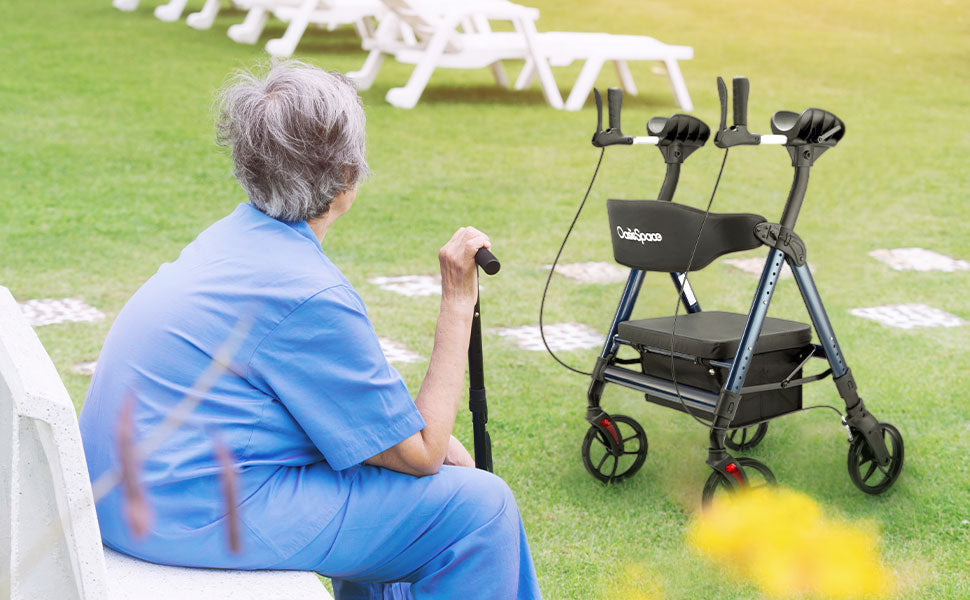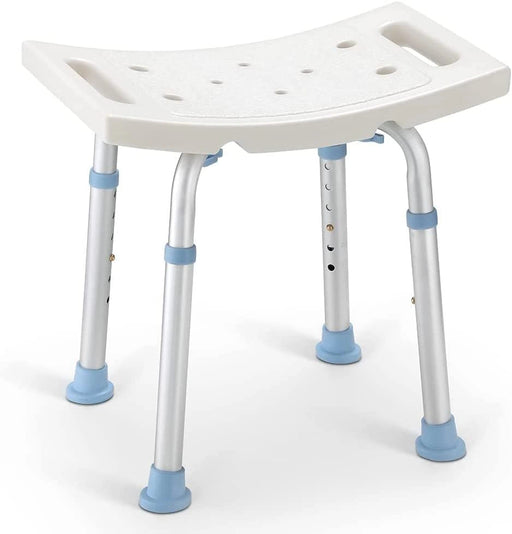
Comprehensive & Must-know Walker Guide
Walkers can be an essential mobility aid for many seniors and people recovering from surgery or injury.
With the variety of walker options on the market, it's important to find one tailored to your needs.
Let's explore some of the most important factors when it comes to walkers.
Types of Walkers
Walkers are not just four-legged metallic aids; they're as diverse as the people who use them. Each type of walker caters to specific needs, enhancing the mobility and independence of the user.a
- Standard Walkers: Standard walkers are the most basic form, comprising four legs and handles. They provide the highest level of stability but require the user to lift them for each step.
- Two-Wheel Walkers: Two-wheel walkers, or front-wheel walkers, have wheels on the front two legs. This design allows for easier movement than standard walkers, without compromising too much on stability.
- Three-Wheel Walkers: Three-wheel walkers, or three-wheel rollators, offer more maneuverability due to their triangular design. They are lighter and more compact, ideal for tighter spaces, but may provide less stability than four-wheel options.
- Rollator Walkers:Also known as four-wheel walkers, rollators offer the greatest mobility. They come equipped with a seat and often include a basket for convenience. However, they may not provide as much stability as standard or two-wheel walkers.
- Upright Walkers:Upright walkers are a newer style designed to allow the user to maintain a more natural, upright posture while using the walker. They usually come with four wheels and a seat.
Key Features to Consider
Some key features to consider when choosing the right type of walker include:
- Wheels- Standard walkers have no wheels, while there are 2-wheeled, 3-wheeled and 4-wheeled models. Wheels make moving easier.
- Folding mechanism- Walkers will fold up for storage and transport. Not all walkers fold.
- Seat- Rollators and upright Walkers will have a seat for resting on longer walks. Standard walkers do not.
- Basket- Baskets let you easily carry items. They are common on rollators and upright Walkers.
- Brakes- Some rollators and upright walkers have brakes on the rear wheels for added safety and control.
- Height- Walkers come in different heights to suit the user. Measure from the floor to the armpits to get the ideal height.
Walker Proper Posture
To get the most benefit and prevent injury when using a walker, it's essential to use Proper Posture:
- Stand Tall
- Position Your Hands Correctly
- Keep Your Walker Close
- Adjust Your Walker
- Take Regular Breaks
- Strengthen Your Core
- Practice Balance Exercises
Safety Tips for Using Walkers
It's important to keep safety in mind when using a walker:
- Inspect it regularly for any loose, broken or worn out parts and tighten or replace as needed. Check rubber tips.
- Be careful using a walker on slippery, wet or uneven surfaces that may cause sudden loss of balance or grip. Avoid thick carpets.
- Don't step into or out of the walker frame, as this can cause tipping. Stand inside the frame to walk.
- Go slow on declines and inclines. Have spots to frequently rest.
- Avoid using on stairs. Use an elevator, ramp or assistance if needed.
- Ensure handles are at wrist height to reduce back strain. Adjust height appropriately.
Walker Health Benefits
When used properly, walkers can provide many benefits:
- Increased stability prevents falls and injuries.
- Upper body weight supported to make walking easier and reduce lower body strain.
- Improved confidence navigating terrain knowing the walker provides support.
- Continued mobility and independence for daily activities.
- Relief from back, hip and leg pain due to less strain on these areas.
- Recovery aid after injuries, surgery, or medical events affecting mobility and balance.
Living Independently with a Walker
Walkers allow many people to maintain their mobility and independence, especially around their own homes:
- Use on short trips to the bathroom, kitchen, bedroom
- Hold often used items like phones nearby to avoid extra walking
- Rearrange furniture placement to create open pathways
- Ensure adequate lighting and remove trip hazards
- Install grab bars, railings, ramps for added support and safety
- Keep the walker nearby for quick access around the house
Maintenance and Care for Walkers
- Periodically inspect the walker for loose screws.
- Wipe down the walker frame regularly with a damp cloth to keep it clean.
- Watch for fraying or tearing of any upholstered handgrips.
- Assess the condition of any wheels and check they spin freely.
- Examine the folding mechanism to ensure it's locking securely.
- Check for any signs of structural fatigue like cracks, bends or breaks.
- Don't hang heavy items from the walker handles as it strains the frame.
- When transporting in a car, restrain it properly to avoid damage.
- Store the walker in a dry location and avoid excess moisture.
When to Seek Medical Guidance
It's advisable to consult a doctor or manufacturer to ensure proper walker fitting and technique. Get guidance if:
- Unsure which type provides the right support
- Have difficulty walking even with a walker
- Experience pain, instability or recent injuries using it
- Need help adjusting the walker for ideal height and use
- Require additional mobility aids along with the walker
Having a professional assessment ensures you get the most suited mobility device and use it safely.
Conclusion
Walkers are an invaluable aid that provides stability and support for mobility around the home and community.
With a range of types and features available, consider individual needs and environment to choose the right model.
Ensure the walker fits correctly, use proper technique, and refresh safety knowledge regularly.
You May Also Like
Proper Posture When Using a Walker
Upright Walker vs Rollator vs Folding Walker: How to Choose?
Something About Beach Walker or Beach Rollator you Must Know
Must-know Safety Tips for Walker Users
How to Use a Rolling Walker Properly
Recommend Products
-
 Sale
Sale
Standard - 300LBS Capacity Shower Stool
Original price $51.99From Original price $28.99Original price $51.99Current price $28.99From $28.99Current price $28.99OasisSpace Medical Square Shower Stool for Bathtub OasisSpace Square Shower Stool for Bathtub is approved as the highest standard(FDA) for medical...
View full detailsSaleOriginal price $51.99From Original price $28.99Original price $51.99Current price $28.99From $28.99Current price $28.99 -
 Sale
Sale
300LBS Capacity Raised Toilet Seat with Arms
Original price $120.99From Original price $69.99Original price $120.99Current price $69.99From $69.99Current price $69.99OasisSpace Raised Toilet Seat with Arms - Safe and Convenient OasisSpace Raised Toilet Seat with Arms provides stable support for users to sit dow...
View full detailsSaleOriginal price $120.99From Original price $69.99Original price $120.99Current price $69.99From $69.99Current price $69.99 -

350LBS Capacity 2 Wheel Walker
From Original price $39.99Original price$39.99From $39.99Current price $39.99Product Advantages OasisSpace's 350LBS Capacity walker offers a fusion of lightweight design and sturdy support, crafted from high-grade anodized ...
View full detailsFrom Original price $39.99Original price$39.99From $39.99Current price $39.99 -

Wall Mounted - 400LBS Capacity Teak Folding Shower Seat
From Original price $131.99Original price$131.99From $131.99Current price $131.99Advantages OasisSpace Teak Wall-Mounted Shower Seat adopts a folding design, which can save space to the greatest extent and can be folded up at a...
View full detailsFrom Original price $131.99Original price$131.99From $131.99Current price $131.99 -
 Sale
Sale
Padded & Bariatric - 500LBS Capacity Heavy Duty Shower Stool
Original price $57.99From Original price $36.99Original price $57.99Current price $36.99From $36.99Current price $36.99OasisSpace Medical Heavy Duty Bariatric Shower Stool OasisSpace Medical Heavy Duty Bariatric Shower Stool is approved by the FDA, which is the hig...
View full detailsSaleOriginal price $57.99From Original price $36.99Original price $57.99Current price $36.99From $36.99Current price $36.99 -
 Sale
Sale
300LBS Capacity Stand Alone Toilet Safety Rail
Original price $69.99From Original price $44.99Original price $69.99Current price $44.99From $44.99Current price $44.99OasisSpace Toilet Safety Rails - Fit Any Toilet OaisSpace stand-alone toilet safety rails provide sturdy support for the elderly and people with ...
View full detailsSaleOriginal price $69.99From Original price $44.99Original price $69.99Current price $44.99From $44.99Current price $44.99







